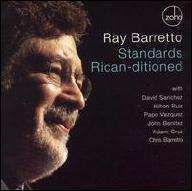Puerto Rican by extraction, Barretto took up the congas while stationed in Germany during an Army hitch. He began working with American jazz musicians upon his return to New York, eventually replacing Mongo Santamaria in the Tito Puente band for four years, beginning in the late '50s. Barretto made his debut as a leader for Riverside in 1962 and scored a crossover hit (number 17 on the pop charts) the following year on Tico with El Watusi (in tandem with a dance craze of the time). He tried to modernize the charanga sound with injections of brass, covering rock and pop tunes of the time as several Latin artists did then. However, Barretto made his main mark in the '60s as a super session player, playing on albums by Gene Ammons, Cannonball Adderley, Kenny Burrell, Lou Donaldson, Red Garland, Dizzy Gillespie, Freddie Hubbard, Wes Montgomery, Cal Tjader, and several other jazz and pop albums.
In moving over to the Fania label in 1967, Barretto began to achieve recognition as one of the leading Latin jazz artists of the day, eventually becoming music director of the Fania All-Stars. In the '70s, he was incorporating rock and funk influences into his music -- with only limited success -- while recording for Atlantic, and in 1981, he made a highly regarded album for CTI La Cuna, with Puente, Joe Farrell, and Charlie Palmieri as guest players. He became music director of the #Bravisimo television program and took part in the multi-idiom, all-star, anti-apartheid Sun City recording and video in 1985. In 1992, he unveiled a new Latin jazz sextet, New World Spirit, which made some absorbingly unpredictable albums for Concord Picante. ~ Richard S. Ginell, Rovi
|
1
|
|
Acid |
|
2
|
|
Pastime Paradise |
|
3
|
|
Margie |











